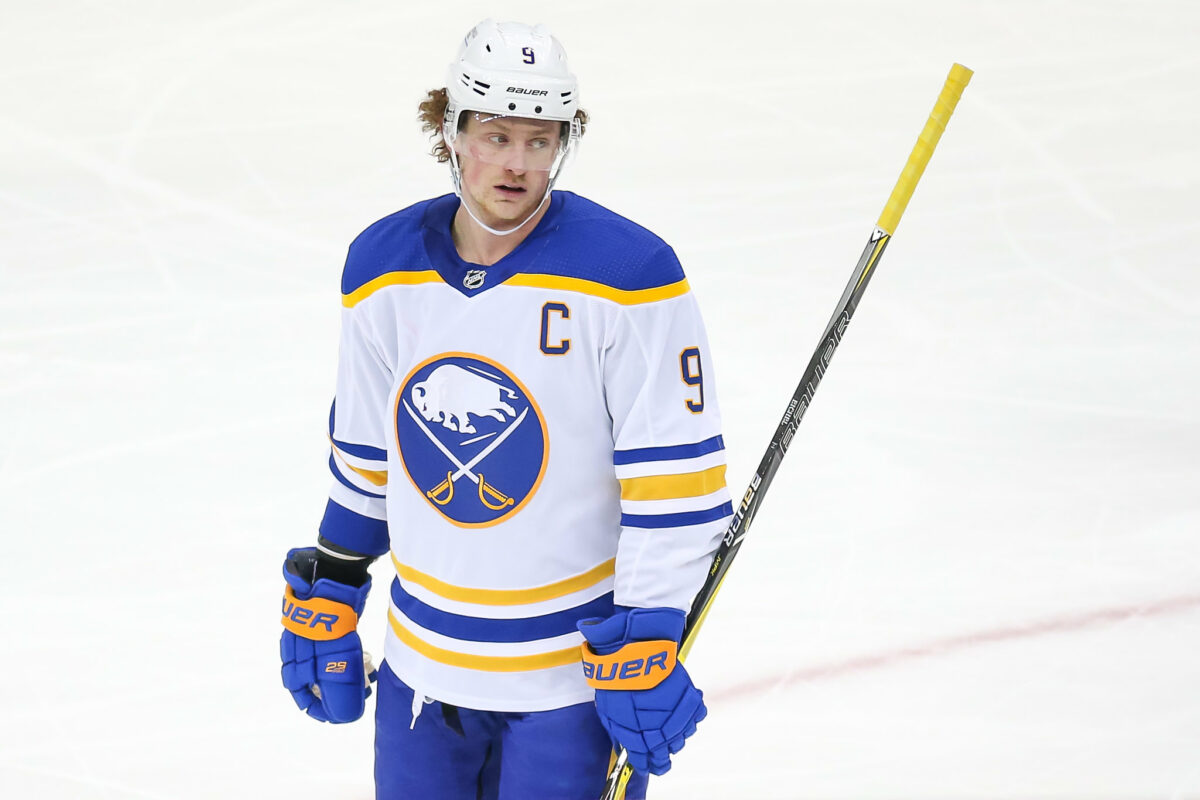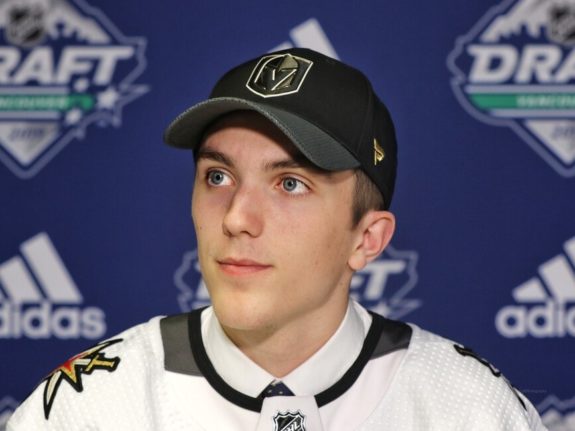The Vegas Golden Knights’ present reality isn’t strikingly different now than it was before Thursday’s blockbuster acquisition of Jack Eichel. They continue trying to work their way out of an early season, injury-induced funk, and the only appreciable trade-related lineup adjustment for now is the absence of Peyton Krebs, who still holds tremendous promise but also produced zero points and a minus-6 in nine games pre-trade.
In a big picture sense, however, the trade’s impact is seismic. Golden Knights general manager (GM) Kelly McCrimmon thought highly enough of Eichel as a player that not only was he prepared to take on the risk of the former Buffalo Sabres captain’s pending unprecedented neck surgery along with the $50 million remaining on his contract, but he surrendered two crucial future assets – Krebs and Alex Tuch – to do so.
It goes without saying that this type of bold, ambitious leap raises just as many questions as it answers. Eichel may be among the league’s best centers, but right now to some Vegas fans, he’s a guy that cost the club another fan favorite in Tuch without even offering any immediate payoff.
Now that the dust has settled on the three-player mega-deal, let’s jump into some of the lingering questions.
How Much can Eichel Help this Year?
Or, in a more specific framing, when will he be back on the ice after recovery from neck surgery? While we don’t yet know the exact date for his artificial disk replacement surgery, the conventional medical wisdom seems to put the 25-year-old’s return in the 3-5 month range (from “Jack Eichel’s neck surgery is no problem for the Golden Knights, but when might he return? A surgeon helps explain,” Jesse Granger, The Athletic, 11/4/21).
And even then, it seems highly optimistic to assume Eichel will pick right back up at the 36-goal pace he enjoyed during his last full season. By the time he’s cleared, he’ll be nearly a year removed from his most recent game, still adjusting to a surgically repaired neck and flanked by an entirely new set of teammates. And if the projected timeline holds, he’ll be asked to adapt in the heat of the late season playoff race.

As a die-hard Toronto Raptors fan, the comparisons to the team’s 2018 trade for San Antonio Spurs star Kawhi Leonard are inescapable. The allure of a title was so strong for both the perpetual playoff-contending Golden Knights and Raptors that they sacrificed a fan favorite (DeMar DeRozan for Toronto) in exchange for a red flag-riddled star. It worked out for the Raptors, so there’s cause for hope in Vegas.
Who Were the Golden Knights Bidding Against?
It certainly hasn’t been an easy year and change in the GM’s chair in Buffalo for Kevyn Adams, but he deserves credit for his handling of what looked to be an unwinnable Eichel saga. From a Vegas standpoint, it’s worth wondering exactly what leverage Adams and the Sabres had to require parting with a solid young middle-six forward, a high ceiling prospect and first- and third-round picks.
In fairness to McCrimmon, it does look like the Calgary Flames and possibly the Carolina Hurricanes had emerged as serious suitors for Eichel’s services. Calgary would’ve been in tough to put together a compelling package without making Matthew Tkachuk available, just as Carolina would unless they agreed to part ways with youngsters Seth Jarvis and Martin Necas.
McCrimmon is still in the early stages of potentially being haunted by the Max Pacioretty-for-Nick Suzuki swap, and so the worry of regret over parting ways with Krebs seems very real at the moment. But just as we don’t know what the club’s 2019 first rounder will amount to, we also may not have yet witnessed the fully realized potential of Eichel, who is only just entering his prime.

And whatever offers the Flames, Hurricanes and whoever else put forward (we’ll ultimately never know), the appeal of a franchise center entering his peak years was ultimately too good to pass on.
Wasn’t Chandler Stephenson Doing Enough?
While some Vegas fans might lament the loss of Tuch in the deal, another Golden Knight being somewhat cast aside for Eichel is Chandler Stephenson, the current de facto No. 1 center. Despite being no one’s idea of a true top-line center, the former Washington Capital has been the most consistent, reliable Knight to date this season, recording 10 points in as many games to lead the team in scoring.
Early in the 2021-22 season, Stephenson has set about proving that he can produce offense without Pacioretty and Mark Stone – both injured – flanking him. Suddenly, the 27-year-old’s contract, with two years and $5.5 million remaining after this one, looks like one of the biggest bargains on the team.
Stephenson’s hot start didn’t deter McCrimmon from making a sizable upgrade down the middle, and rightfully so. One year after the GM found himself fielding questions about the organization’s depth down the middle, the Golden Knights can now safely consider the center position a strength, boasting – when all are eventually healthy – Eichel, William Karlsson, Stephenson, Nolan Patrick and Nicolas Roy (from “Center depth not an issue for Golden Knights, GM says,” Ben Gotz, Las Vegas Review-Journal, 10/9/20).
How can the Golden Knights Fit Everyone Under the Cap?
McCrimmon would surely be the first to remind you that the cap headache that awaits won’t have to be faced for a few months. Still, he simply wouldn’t have been doing his job properly if he didn’t construct some plan regarding how he’d fit all this talent and all of these cap hits onto one roster, particularly while keeping things at or under $81.5 million.
Related:
- 9 NHL Teams That Missed in Free Agency
- Golden Knights Will Miss Jonathan Marchessault
- Islanders’ Lamoriello Needs to Follow Golden Knights’ Ruthless Trade Model
- Golden Knights Struggling to Address Voids in Forward Corps
- Golden Knights Took Major Risk With 1st-Round Pick Trevor Connelly
As of now, the Golden Knights have nearly $30 million worth of cap commitments sitting in Long Term Injured Reserve (LTIR), alone. In fact, without the long-term injuries to Stone, Pacioretty and others, the club wouldn’t have even been in position to make the move in the first place without more salary going out (from “How will the over-the-cap Golden Knights fit in Jack Eichel’s huge salary when he returns?,” Jesse Granger, The Athletic, 11/5/21).
Assuming for a Golden Knights roster that will get progressively healthier – hence, bring players off of LTIR – ahead of Eichel’s return/debut, there are a few potential paths to balancing out the cap kerfuffle, albeit none ideal. Finding takers for players like Evgeni Dadonov ($5 million cap hit) or Laurent Brossoit ($2.35 million) could help, but the easier path may come in dealing pending free agents Reilly Smith ($5 million) and/or Brayden McNabb ($2.5 million).
Both Smith and McNabb are valued Vegas originals, but they are unlikely to return past this season and can ultimately be replaced. Dadonov could take Smith’s second line role, while McNabb’s minutes could still be filled by Nicolas Hague, who wasn’t included in the Eichel trade despite rumored involvement. Hague could even be a sweetener added to unload salary, as he may become prohibitively expensive in restricted free agency.
The Eichel acquisition further underlines the general mindset in Vegas: the regular season is a formality and we only have the playoffs to concern ourselves with. In hindsight, even knowing their cap situation, it shouldn’t be all that surprising that the team with the well-established appetite for risk in the name of winning would make this move. Now, let’s see if it pays off.